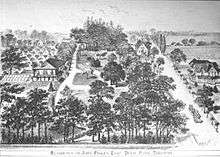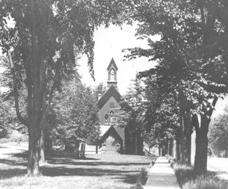Deer Park, Toronto
| Deer Park | |
|---|---|
| Neighbourhood | |
|
Christ Church in Yonge St Gore | |
|
Location of Deer Park within Toronto | |
| Country |
|
| Province |
|
| City |
|
Deer Park is a neighbourhood in Toronto, Ontario, Canada, centred on the intersection of Yonge Street and St. Clair Avenue; its boundaries are the Vale of Avoca section of Rosedale ravine in the east, Farnham Avenue and Jackes Avenue in the south, Avenue Road and Oriole Parkway in the west, the Belt Line trail in the north on the west side of Yonge Street, and Glen Elm Avenue in the north on the east side of Yonge Street. For the purposes of social policy analysis & research, the City of Toronto’s Social Development & Administration division includes Deer Park within the City of Toronto's official "Rosedale-Moore Park" and "Yonge-St.Clair" neighbourhood profiles. The neighbourhood is in Ward 22, represented by Councillor Josh Matlow at Toronto city council.
The commercial area along the main streets is known simply as Yonge and St. Clair. Marked by a cluster of office buildings, the area also includes a number of restaurants, shops and services, and the St. Clair subway station, the terminus for the 512 St. Clair street car.

History
The name dates from 1837, when the Heath family purchased 40 acres (162,000 m²) of land on the northwest corner of Yonge and St. Clair (then the Third Concession Road) and named it Deer Park. By the 1850s the neighbourhood included a racetrack, a school, and a hotel at which patrons could feed deer which roamed the Heaths' property. The Heath property was subdivided in 1846 and was entirely sold off by 1874.
In 1891 Upper Canada College moved from its urban location to the then still rural Deer Park area, establishing a large campus that remains in the same location today, interrupting Avenue Road north of St. Clair Avenue.
In 1931 De La Salle College (Toronto) moved from its downtown location to an estate named 'Oaklands' originally purchased and built upon by Senator John Macdonald in 1858. Oaklands forms part of the southern boundary of Deer Park, running eastward along the escarpment from Avenue Road.[1]
Deer Park was annexed by the City of Toronto in 1908, and by the 1930s it had become an upper-middle class residential district, which it remains today. The intersection of Yonge and St. Clair is also the site of extensive nodal commercial development.
Deer Park is also home to one of Toronto's oldest cemeteries. St. Michael's Cemetery (Toronto) was opened by the Roman Catholic Archdiocese of Toronto on September 28, 1855. There are some 29,000 graves in the cemetery. Ten acres in size, St. Michael's has the unusual characteristic of being surrounded on all sides by the backs of buildings, thus making it nearly invisible from the street. It is bound on the north by stores, apartments and office buildings along St. Clair Avenue West, on the west by houses along Foxbar Road, on the south by houses and a fire hall along Balmoral Avenue, and on the east by stores and office buildings along Yonge Street. Entrance to the cemetery is gained through an alley off Yonge Street. The cemetery's octagonal mortuary vault was used to store bodies in the winter until the ground thawed. Designed by architect Joseph Sheard, who was also mayor of Toronto in 1871-72, the vault was designated a historic property under the Ontario Heritage Act in December 1975.
In 1999 Robert Fulford described the current character of the neighbourhood: "sandwiched between Forest Hill on its western flank and Moore Park to the east, Deer Park is utterly unlike either of them—it's more commercial, a fast-changing community dominated by apartment dwellers."[2]
Notable houses
- 40 Heath Street West
At one time owned by the Anglican Church of Canada, Archbishop Desmond Tutu stayed in the house which was used for visiting Clerical dignitaries. The police occupied the house while staking out the Boyd Gang which resulted in their arrest as noted below.
- 42 Heath Street West
After a stakeout, Canada's most notorious bank robber of the day, Edwin Boyd, leader of the Boyd Gang, was captured in this house at 6:00AM on March 15, 1952. Even Toronto's mayor of the day, Allan Lamport, got into the act, escorting Boyd out of the house accompanied by Sergeant Adolphus (Dolph) Payne of the Toronto police force.
- 50 Heath Street West
Constructed in 1923, the McNamara House is a rare example of the Prairie School of architecture in Toronto.
- 131 Farnham Avenue
Currently home to De La Salle College (Toronto), an estate named "Oaklands" was once part of the Crown Lands deeded to Honourable John Elmsley in 1798. In 1858, Senator John Macdonald—a successful dry goods merchant who would become the only Liberal appointee to the Senate by Canada's founding Prime Minister, Sir John A. Macdonald—acquired 35 acres (140,000 m2) of it from the Anglican Church. The Oaklands mansion has been designated as a historical building by the City of Toronto as an example of local Gothic architecture.[3]
Famous former residents
- Classical pianist Glenn Gould (1932–82) lived in Apt. 902 at 110 St Clair Avenue West from 1962 until his death in 1982. He is buried in nearby Mount Pleasant Cemetery.
- J. E. H. MacDonald, a founding member of the Group of Seven painters, lived at 40 Duggan for several years until his death on September 26, 1932.
- Pierre Salinger (1925–2004) was press secretary to presidents John F. Kennedy and Lyndon Johnson, and campaign manager to Robert F. Kennedy. He was mere metres away when R.F.K. was assassinated. He lived at 37 Lonsdale Road, while very young, from 1929-1932/3.
- Novelist Joy Fielding (b. 1945) wrote Kiss Mommy Goodbye while living at 83 Lonsdale Road during the last three years of the '70s.
- Writer Farley Mowat (1933–2014) lived at 90 Lonsdale Road for six months in 1939-40.
- Poet Margaret Avison (1918–2007) lived in Apt. 104 at 150 St Clair Avenue West from 1964-70.
- Actor William Hutt (1920–2007) lived at 18 Ferndale Avenue for several years in his childhood.
- Architect Rod Robbie (1928-2012), lived at 16 Cornish Road from 1966 until his death. He and his wife Enid Robbie are buried at Mount Pleasant Cemetery.
Schools
- Deer Park Public School - A public school located at 23 Ferndale Avenue. It has been serving the community for about 125 years. The current principal is Bill Waldman and the current vice-principal is Chris Gorczynski. Deer Park has many challenging academic, sport and art programs. They include basketball, football, ultimate frisbee, Me To We club, swim team and the theatre production. Deer Park serves students from kindergarten to grade 8.
- Upper Canada College
- De La Salle College (Toronto)
See also
Significant buildings
Churches
References
- Gatenby, Greg: Toronto: A Literary Guide, McArthur and Company; Toronto, 1999. ISBN 1-55278-073-2
- Kinsella, Joan C.: Historical Walking Tour of Deer Park, Toronto Public Library Board; Toronto, Ontario, 1996. ISBN 0-920601-26-X
External links
- City of Toronto Rosedale-Moore Park neighbourhood profile
- mystclair.com
- http://catholic-cemeteries.com/st_mikes_history.html
 |
Davisville Village |  | ||
| Forest Hill | |
Moore Park | ||
| ||||
| | ||||
| Summerhill, Rosedale |
Coordinates: 43°41′17″N 79°23′38.5″W / 43.68806°N 79.394028°W
